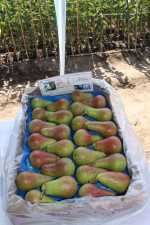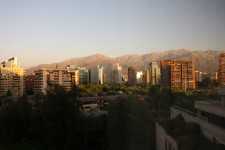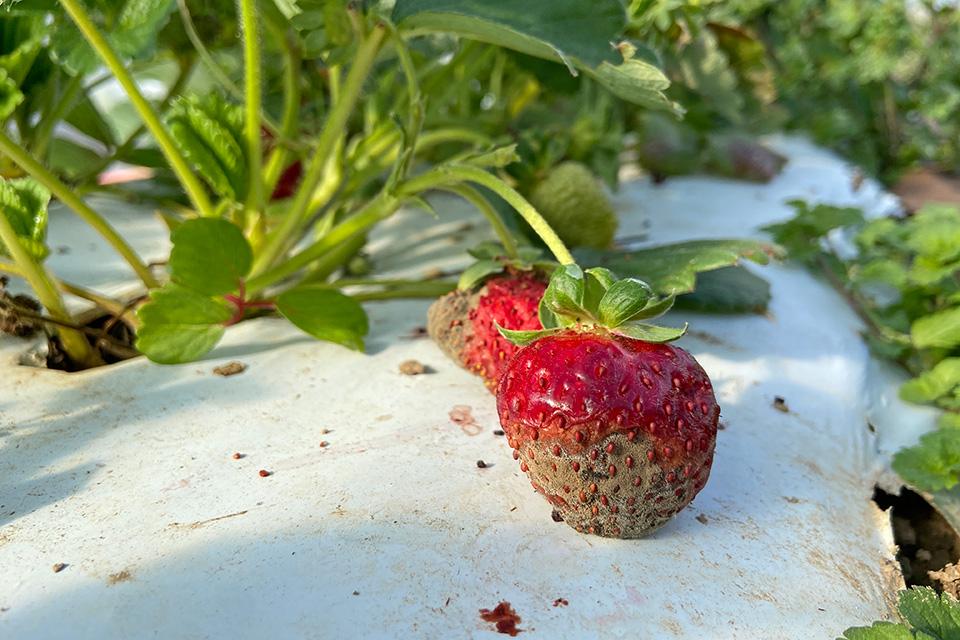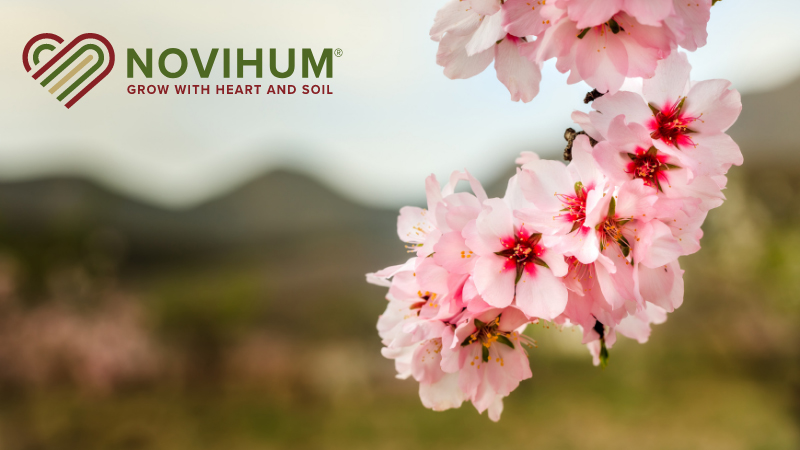2012 IFTA Conference: Lessons in Export, Harvest Timing, And Packout Efficiency

The International Fruit Tree Association (IFTA), founded in 1958, recently finished its 55th annual conference and orchard tours in Santiago, Chile. With a mission to “promote an understanding of the nature and use of dwarf trees through research, education, and dissemination of information,” as well as, “to be the leading international organization advancing intensive orchard systems,” it is clear that this year’s conference was right on par with the group’s goals.
With two days of sessions at the Grand Hyatt Santiago, and orchard tours from Chile to Brazil and Argentina, none of the 300-plus attendees walked away empty handed when it came to information. As Gary Mount, of Terhune Orchards in New Jersey and board member for IFTA explains, “We have always emphasized the free flow of information from growers around the world. These meetings and tours have been at some of the most productive orchards on earth.”
Speakers that facilitated this information ranged from university professors from the host country to Extension representatives and growers from around the globe. In reference to the speakers, Phil Schwallier, district horticulture marketing agent with Michigan State University and board member of the IFTA, explained that, “the speakers presented outstanding perspectives and information. The work that each of them presented amazed the audience with its practical, applied use, and cutting edge message.”
The location for this year’s trip was carefully chosen, as Mo Tougas of Tougas Family Farms and president of the IFTA says, “because there is such a strong presence of Chilean fruit in the Northern hemisphere during our winters, and also because of the connections that IFTA has with the industry.” In addition, Schwallier described the reason the country was chosen as, “it is rapidly growing as a horticultural leader in fruit production and marketing.” Furthermore, Schwallier said that, “we always wanted to choose Chile as a site for an annual conference, this year it just worked out. Cornell University’s Dr. Terence Robinson’s working relationship with the Chilean agriculture industry made the decision to choose the country easy.”
The Land Of Plenty
Apart from professional relationships, however, the first speakers at the conference made it clear why Chile is a force to be reckoned with on the world stage. President of the Association of Chilean Exporters (Asociaion de Exportadores de Chile, ASOEX), Ronald Brown, initiated the conversation as to why Chile was chosen, calling it a, “trustworthy, worldwide provider of fresh fruit.” The country has more than 7,800 producers of fresh fruit and 727 companies that export to 1,700 importers and employ more than a million people in the agriculture industry alone.
Part of the reason that Chile is able to have such a massive and varied industry, Brown explained, is the fact that the country itself is long, spanning six completely different climates. These climates include a desert climate located in the far north, a semi-arid climate found in the near north, a Mediterranean climate found in central Chile, a temperate oceanic climate found in the near Southern part of the country, and a sub polar oceanic climate in the Austral zone, or the far South. These different environmental elements have allowed the country to produce such a variety of fruit including grapes, apples, cherries, pears, avocadoes, peaches, and more.
What the country’s professionals have learned working in such a diverse country was put on the table in a marathon conference of dual 10-hour days. “For those of us used to being outdoors, that is pretty heavy lifting!” Mount said of the multitude of sessions. He did, however, go on to say that, “the last session of the day was still packed, and looking around you just had to say, ‘my gosh, everyone is still here!’ and that’s remarkable.”
Providing For The World
One of the topics that kept the room packed was the business plan Chile utilizes that earned it the status it holds today. “Someone in New York can eat a fresh Chilean cherry in the middle of winter,” Antonio Walker Prieto, president of Fede Frut explained. Mount said that, “most of the time when we go to a place, we see substantial local consumption followed by export, but in Chile they are very dependent on export as a primary focus.”
One of the tour leaders went so far as to exclaim, “It’s all about the packout!” He explained that the domestic market is too cheap for what is spent on production. The emphasis on international consumption of Chilean goods is clearly working to their advantage, and, as Prieto explained, the country has seen a 24% increase in exporting from the previous year, a huge feat in the world’s economy.
This does, however, present unique logistical challenges that countries with internalized consumption don’t generally face. “They have to be really sharp,” Mount explained. “They cannot have a misstep.” Having grown to be the largest exporter in the Southern hemisphere, though, it seems like the Chilean industry has the system down to a science.
Professor Rodrigo Infante of the University of Chile, in his session on cultivars of stone fruit and new business patterns for the industry, explained that much of the country’s fruit has to travel for approximately 45 days to meet its destination. In order to meet these needs, Infante also explained that to evaluate the quality of his fruit after producing it to meet the needs of export, he utilizes two teams of sensory quality assessment personnel, one trained, and one untrained. The trained group provides him with information regarding the quality and texture of the fruit while the untrained group of 100 participants answers a basic question for him: “Do you like it, or not?”
While it may seem like a fairly basic question, the assessment reveals specific details important to the world market, including the value of things like juice content, crunchiness, firmness, and compression strength. In addition, Infante explained that six Chilean fruit export companies have been granted test agreements and are able to test new genotypes of produce for years in their own conditions, something highly important to the unique environments that Chile is known for.
Standards And Practices
Many of the attendees were interested to know the conditions under which the fruit was produced, packed, and shipped, and the rules that governed these systems. Mount explained that he and the group, “visited a facility that did pre-inspections for insect pests. It was a joint project between Chile and the USDA,” and he was, “so impressed by how seriously they took it. It went a long way toward easing concerns as a U.S. grower as to how that’s done.
“We visited another facility that pre-inspected fruit shipments from Chile destined for other countries, and it was extremely well done and the people were intent on their jobs and had everything very professionally figured out as far as how much of a shipment needed to be sampled for quality, along with other details,” he continued. In closing, Mount stated that, “One of the things that growers here worry about is if other countries are playing by the rules and doing the right thing, so this was wonderful to see.”
The great coordination the country has established with all of these elements is highly impressive in itself, due to the fact that, as Tougas explains, “with no Extension service, growers depend on advisors for information and some may not be as active in seeking direct contact with researchers.”
This lack of information to growers has not stopped them in their sojourn; however. As Prieto explained in his session, “we went out into the world and saw that we have an opportunity to dominate.” This attitude of going out into the world and gathering information and new ideas was expanded upon by an orchard owner who said that the industry as a whole has been looking to Italy as inspiration for mechanization (among other things), and, more specifically, the use of platforms.
This interest in mechanization may be largely due to the high cost of labor in comparison to what is earned from the produce. Field workers in the apple industry in Chile average $30 to $35 a day, with 1,500 hours spent per year per hectare. This is not too different from the wage given to those in the cherry fields, which is $35 a day with an average time spent of 45 hours per week. The cost of labor remains the same for apple orchards, where there is an average of 2,000 good trees per hectare. Pears, on the other hand average 1,250 trees per hectare with 40 to 45 tons of produce put out per hectare.
For a better idea of the operations visited, take Univiveros of the Unifrutti Group, the location of the first day’s tour at the conference. Univiveros, an operation with 25 years under its belt and an income of more than $10 million, produces a wide range of apple, pear, and cherry varieties and rootstocks. Univiveros has also been key in providing the first generation of stone fruit varieties bred completely in Chile in coordination with the Universidad de Chile in a program called Australis Breeding.
Growing and selling more than four million plants per year, Univiveros has more than 300 hectares for nursery purposes. The visit revolved around the Field Nursery Unit, where apple, pear, cherry, and stone fruit is grown.
A topic of great interest in the fields was the growing conditions and the varieties that the country utilizes for export. As far as apples are concerned, Felipe Massanes, product manager for pome and cherry trees, explained that due to the fact that Asia and Chile still very much want stripes, their fields are focusing mostly on Brookfield Gala. Furthermore, they have seen that Pink Lady has been replaced by Rosy Glow due to demand.
In addition to their choices of varieties for the demands of the foreign consumers, Massanes explained that they need color to ship, and things have to be ready on time for summer in Europe. In order to get the desired color in time, the use of Colorup, an alloy foil that covers 1.2 meters and works as a mirror to distribute light, has been utilized. In addition, the importance of management of fruit per tree to achieve the ever-important size was stressed. The trees being cultivated by Univiveros include K-nip and finished apple trees, apple trees on Cornell Geneva rootstocks, cherry trees including finished trees and chipbudded plants, and stone fruit trees such as finished trees and chipbudded plants.
According to Tim Welsh of Columbia Fruit Packers in Washington and board member with the IFTA, “the tours that follow the conference are information gold mines, and bus rides are as important as field visits. To have a captive audience for hours on end in a bus makes for the best classroom experience ever.”
There is no doubt that these life experiences can only grow one’s success in the field. “This has influenced me without a doubt,” Mount concluded. “It has helped me to be a better fruit grower, and better as a whole.”
For information regarding 2012’s hall of fame inductee, Gary Mount, go to page two
For information regarding comments from attendees around the world, go to page three
Gary Mount Inducted Into The Hall Of Fame

This year’s award ceremony gave the International Fruit Tree Association the opportunity to recognize the efforts of various contributors. One IFTA member, Gary Mount of Terhune Orchards, LLC, however, was recognized as an invaluable member of the agriculture community, and was inducted into the association’s Hall of Fame, an honor only bestowed on a select few members over the years.
“We believe it is fitting to honor only a limited number of individuals who have given much of their time and talent,” explains Mo Tougas, president of the IFTA. “We do not feel compelled to find a Hall of Fame member every year.”
Of Mount’s contributions, he has been an active contributor at all of the conferences since 1988, and a member since the late ‘70s. Mount has served on the board of directors and, most importantly, the Rootstock Research Committee, which he chaired for the past 15 years. He is also a founding trustee and secretary/treasurer of the IFTA Research Foundation.
Visibly shocked by the honor, Mount explained that his wife and daughter had gone to extreme measures to keep the award under wraps by breaking into his computer and wiping it clean of any prior warning of the honor.
Mount explains his favorite thing about the group is its fierce independence and go-to attitude. “They feel like, as a group, that if they want to support the industry and the research that’s going on, as well as have the ability to direct it, they need to do it themselves.”
Mount says that, “to be considered a person that has made a difference to the organization and the industry is super.”
For information regarding comments from attendees around the world, go to page three
Heard Around The World…

One of the most impressive things about the IFTA Conference is the convergence of professionals from around the world. Enriching conversations and bringing new points of view and fresh ideas, this combination of people contributes just as much as the take away.
Below are thoughts from just a few of these participants on what they learned at this year’s sessions and orchard tours.
“Brazil’s know-how in the use of chill compensators could be very useful for certain areas of Mexico. Additionally, the use of plant growth regulators in South America is impressive.”
Luis Gutierrez,
Desarrollo Agroindustrial
del Norte, Mexico
“Interesting lectures were the highlight for me. Desmond O’Rourke discussed apple variety clubs, saying that the costs are often higher, the learning curve is longer, and the returns are weaker than expected. Terence Robinson of Cornell University also delivered an excellent lecture on the history of the Geneva Rootstock program.”
Burgert W. Van Dyke,
Sapo Trust, South Africa
“The conference as a whole made me realize that the Chilean fruit industry is probably one of the most professional fruit industries in the world. I was amazed at how well R&D is targeted to the industry’s real needs and how well competitors succeed in defining common goals to improve their global competitiveness.”
Willy Dillen,
Acutifolius BVBA, Belgium
“As an apple grower, the most important information to me was the discussion about the growing systems, mainly solaxe and tall spindle.”
Ney O. Araldi,
Fischer SA, Brazil
“The Chilean speakers gave us a great insight into their industry. They shared information about their successes in the world markets and work they are doing to improve labor efficiency and orchard productivity.”
Jack Hughes,
Fruition Horticulture Ltd.,
New Zealand









